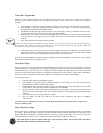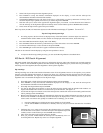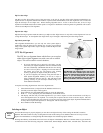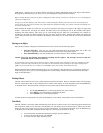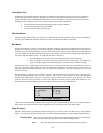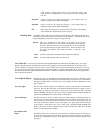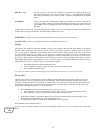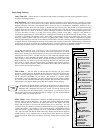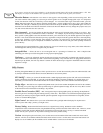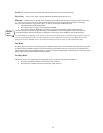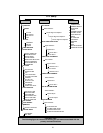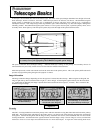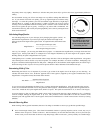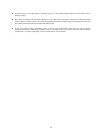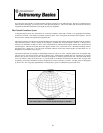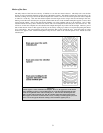
24
If you want to explore the entire object database, set the maximum altitude limit to 90º and the minimum limit to –90º. This
will display every object in the database lists regardless of whether it is visible in the sky from your location.
Direction Buttons –The direction a star moves in the eyepiece varies depending on the accessories being used. This
can create confusion when guiding on a star using an off-axis guider versus a straight through guide scope. To compensate
for this, the direction of the drive control keys can be changed. To reverse the button logic of the hand control, press the
MENU button and select Direction Buttons from the Utilities menu. Use the Up/Down arrow keys (10) to select either the
azimuth (left and right) or altitude (up and down) button direction and press ENTER. Pressing ENTER again will reverse
the direction of the hand control buttons from their current state. Direction Buttons will only change the eyepiece rates (rate
1-6) and will not affect the slew rates (rate 7-9).
Goto Approach - lets the user define the direction that the telescope will approach when slewing to an object. This
allows the user the ability to minimize the effects of backlash For example, if your telescope is back heavy from using
heavy optical or photographic accessories attached to the back, you would want to set your altitude approach to the negative
direction. This would ensure that the telescope always approaches an object from the opposite direction as the load pulling
on the scope. Similarly, if using the CPC polar aligned on a wedge, you would want to set the azimuth approach to the
direction that allows the scope to compensate for different load level on the motors and gears when pointing in different
parts of the sky.
To change the goto approach direction, simply choose Goto Approach from the Scope Setup menu, select either Altitude or
Azimuth approach, choose positive or negative and press Enter.
Autoguide Rate – Allows the user to set an autoguide rate as a percentage of sidereal rate. This is helpful when
calibrating your telescope to a CCD autoguider for long exposure photography.
Cordwrap - – Cord wrap safeguards against the telescope slewing more than 360º in azimuth and wrapping accessory
cables around the base of the telescope. This is useful when autoguiding or any time that cables are plugged into the base of
the telescope. By default, the cord wrap feature is turned off when the telescope is aligned in altazimuth and turn on when
aligned on a wedge.
U
U
t
t
i
i
l
l
i
i
t
t
y
y
F
F
e
e
a
a
t
t
u
u
r
r
e
e
s
s
Scrolling through the MENU (9) options will also provide access to several advanced utility functions within the CPC such
as; Compass Calibration, Periodic Error Correction, Hibernate as well as many others.
GPS On/Off - Allows you to turn off the GPS module. When aligning the telescope, the CPC still receives information,
such as current time, from the GPS. If you want to use the CPC database to find the coordinates of a celestial object for a
future date you would need to turn the GPS module off in order to manually enter a date and time other than the present.
Wedge Align – The CPC has two equatorial alignment modes (one for the northern hemisphere and one for the southern)
that will help you to polar align your telescope when using an optional equatorial wedge. See the Astronomy Basics section
of the manual for more information on the Wedge Align feature.
Periodic Error Correction (PEC) - PEC is designed to improve photographic quality by reducing the amplitude of
the worm gear errors and improving the tracking accuracy of the drive. This feature is for advanced astrophotography and is
used when your telescope is polar aligned with the optional equatorial wedge. For more information on using PEC, see the
section on “Celestial Photography”.
Light Control – This feature allows you to turn off both the red key pad light and LCD display for daytime use to
conserve power and to help preserve your night vision.
Factory Setting – Returns the CPC hand control to its original factory setting. Parameters such as backlash
compensation values, initial date and time, longitude/latitude along with slew and filter limits will be reset. However, stored
parameters such as PEC and user defined objects will remain saved even when Factory Settings is selected. The hand
control will ask you to press the "0" key before returning to the factory default setting.
Version - Selecting this option will allow you to see the current version number of the hand control and motor control
software. The first set of numbers indicate the hand control software version. For the motor control, the hand control will
display two sets of numbers; the first numbers are for azimuth and the second set are for altitude.
Observing
Tip!



